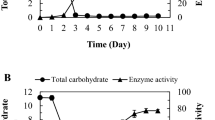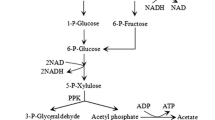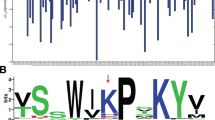Abstract
A novel dextransucrase gene, DSRN, was obtained by ultrasoft X-ray treatment of the DSRB742 gene. The DSRN gene was further mutated via site-directed mutagenesis producing four mutants: DSRN1 (F196S), DSRN2 (Y346N), DSRN3 (K395T) and DSRN4 (P980T). Dextransucrases derived from DSRB742 and its mutants were expressed in E. coli and affinity-purified using dextran to give 80% purity. They had specific activities of 0.6–17 U/mg with Km values of 18–88 mM. DSRB742 had the lowest (0.02 s−1 · mM−1) and DSRN1 had the highest (0.13 s−1 · mM−1) Kcat/Km values. DSRN3 had the highest enzymatic transglycosylation efficiency with maltose (63% of theoretical), gentiobiose (39%), or salicine (40%).




Similar content being viewed by others
References
Arguello-Morales M, Sanchez-Gonzalez M, Canedo M, Quarsco M, Farres A, Lopez-Munguia A (2005) Proteolytic modification of Leuconostoc mesenteroides B-512F dextransucrase. Ant van Leeuwen 87:131–141
Bustin SA (2002) Quantification of mRNA using real-time reverse transcription PCR (RT-PCR): trends and problems. J Molecular Endocrinol 29:23–39
Dols M, Remaud-Simeon M, Willemot RM, Vignon M, Monson P (1998) Characterization of the different dextransucrase activities excreted in glucose, fructose, or sucrose medium by Leuconostoc mesenteroides NRRL B-1299. Appl Environ Microbiol 64:1298–1302
Funane K, Ishii T, Terasawa K, Yamamoto T, Kobayashi M (2004) Construction of chimeric glucansucrases for analyzing substrate-binding regions that affect the structure of glucan products. Biosci Biotechnol Biochem 9:1912–1920
Funane K, Ishii T, Hiroshi O, Kobayashi M (2005) Changes in linkage pattern of glucan products induced by substitution of Lys residues in the dextransucrase. FEMS Lett 579:4739–4745
Haas W, Banas J (2000) Ligand-binding properties of the carboxyl-terminal repeat domain of Streptococcus mutans glucan-binding protein A. J Bacteriol 182:728–733
Holt SH, Al-Sheikh H, Shin KJ (2001) Characterization of dextran-producing Leuconostoc strains. Lett Appl Microbiol 32:185–189
Jana S, Deb JK (2005) Strategies for efficient production of heterologous proteins in Escherichia coli. Appl Microbiol Biotechnol 67:289–298
Kang HK, Seo ES, Robyt JF, Kim D (2003) Directed evolution of a dextransucrase for increased constitutive activity and the synthesis of a highly branched dextran. J Mol Catalysis : Enzymatics 26:167–176
Kato C, Nakano Y, Lis M, Kuramitsu HK (1992) Molecular genetic analysis of the catalytic site of Streptococcus mutans glucosyltransferases. Biochem Biophys Res Commun 189:1184–1188
Kim D, Robyt JF (1994) Properties of Leuconostoc mesenteroides B-512FMC constitutive dextransucrase. Enzyme Microbial Technol 16:1010–1015
Kim D, Kim YM, Park MR, Ryu HJ, Park DH, Robyt JF (1999) Enzymatic modification of cellulose using Leuconostoc mesenteroides B-742CBM dextransucrase. J Microbiol Biotechnol 9:529–533
Laemmli UK (1970) Cleavages of structural proteins during the assembly of the head of bacteriophage T4. Nature 227:680–685
Monchois V, Reverte A, Remaud-Simeon H, Monsan P, Willemot RM (1998) Eject of Leuconostoc mesenteroides NRRL B-512F dextransucrase carboxy-terminal deletions on dextran and oligosaccharide synthesis. Appl Environ Microbiol 64:1649–1655
Monchois V, Willemot RM, Monsan P (1999) Glucansucrases: mechanism of action and structure-function relationships. FEMS Microbiol Rev 23:131–151
Moon YH, Lee JH, Ahn JS, Nam SH, Oh DK, Park DH, Chung HJ, Kang SS, Day DF, Kim D (2006) Synthesis, structure analyses, and characterization fo novel epigallocatechin gallate (EGCG) glycosides using the glucansucrase from Leuconostoc mesenteroides B-1299CB. J Agric Food Chem 54:1230–1237
Mooser G, Hefta SA, Paxton RJ, Shively JE, Lee TD (1991) Isolation and sequence of an active-site peptide containing a catalytic aspartic acid from two Streptococcus sobrinus glucosyltransferases. J Biol Chem 266:8916–8922
Park MR, Ryu HJ, Choe JY, Robyt JF (2001) Characterization of Leuconostoc mesenteroides B-742CB dextransucrase expressed in E. coli. J Microbiol Biotechnol 11:628–635
Remaud-Simeon M, Villemot R, Sarcabal P, Montalk GP, Monsan P (2000) Glucansucrases: molecular engineering and oligosaccharide synthesis. J Mol Catalysis : Enzymatics 10:117–128
Russell RRB (1990) Molecular genetics of glucan metabolism in oral Streptococci. Arch Oral Biol 35:53S–58S
Ryu HJ, Kim D, Seo ES, Kang HK, Lee JH, Yoon SH, Cho JY, Robyt JF, Kim DW, Chang SS, Kim SH, Kimura A (2004) Identification of amino acids residues for key role in dextransucrase activity of Leuconostoc mesenteroides B-742CB. J Microbiol Biotechnol 14:1075–1080
Sanchez-Gonzalez M, Alagon A, Rodriguez-Sotres R, Lopez-Munguia A (1999) Proteolytic processing of dextrasucrase of Leuconostoc mesenteroides. FEMS Lett 181:25–30
Seo ES, Lee JH, Park JY, Kim D, Han HS, Robyt JF (2005) Enzymatic synthesis and anti-coagulant effect of salicin analogs by using the Leuconostoc mesenteroides glucansucrase acceptor reaction. J Biotechnol 117:31–38
Zahnley JC, Smith MR (2000) Cellular association of glucosyltransferases in Leuconostoc mesenteroides and effects on detergent on cell association. Appl Biochem Biotechnol 87:57–70
Acknowledgements
This work was mostly supported by International Cooperative Research Program, Korea Science and Engineering Foundation (Grant M60402010002-05A0201-00210), and partially by Post-doc supporting program of Korean Research Foundation Grant (KRF-2005-216-C00055) and CNU Specialization Grant by Chonnam National University for students.
Author information
Authors and Affiliations
Corresponding author
Rights and permissions
About this article
Cite this article
Nam, S.H., Ko, E.A., Jang, S.S. et al. Maximization of dextransucrase activity expressed in E. coli by mutation and its functional characterization. Biotechnol Lett 30, 135–143 (2008). https://doi.org/10.1007/s10529-007-9498-z
Received:
Revised:
Accepted:
Published:
Issue Date:
DOI: https://doi.org/10.1007/s10529-007-9498-z




